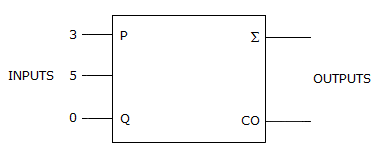Discussion
Home ‣ Digital Electronics ‣ Digital Arithmetic Operations and Circuits Comments
- Question
Solve this binary problem: 1001 × 1100 = ________.
Options- A. 01110001
- B. 01111000
- C. 01101100
- D. 01101110
- Correct Answer
- 01101100
- 1. The circuit shown is a(n) ________.

Options- A. multiplexer
- B. adder
- C. comparator
- D. converter Discuss
- 2. ?910 represented in eight-bit two's-complement notation is ________.
Options- A. 11110111
- B. 11111001
- C. 11110110
- D. 01111101 Discuss
- 3. If no bits are designated inside square braces, [ ], it means the variable is the null set.
Options- A. True
- B. False Discuss
- 4. The range of negative numbers when using an eight-bit two's-complement system is ?1 to ?128.
Options- A. True
- B. False Discuss
- 5. The VHDL compiler requires libraries to be specified at the beginning of the code if components from those libraries are being used.
Options- A. True
- B. False Discuss
- 6. Solve this binary problem: 01011000 ÷ 00001011 = ________.
Options- A. 1010
- B. 0110
- C. 1000
- D. 1110 Discuss
- 7. The carry-out of a full adder is ________.
Options- A.

- B.

- C.

- D.
 Discuss
Discuss
- 8. In BCD addition, the value ________ is added to any invalid code group.
Options- A. 010101
- B. 0U812
- C. 100110
- D. 0110 Discuss
- 9. In AHDL macrofunctions, the first thing that should go into any source file is ________ your code.
Options- A. a field of comments that documents
- B. a library of
- C. a function name of
- D. the universal global definition of Discuss
- 10. The binary adder circuit is designed to add ________ binary number(s) at a time.
Options- A. 1
- B. 3
- C. 2
- D. 5 Discuss
Digital Arithmetic Operations and Circuits problems
Search Results
Correct Answer: adder
Correct Answer: 11110111
Correct Answer: False
Correct Answer: True
Correct Answer: True
Correct Answer: 1000
Correct Answer:

Correct Answer: 0110
Correct Answer: a field of comments that documents
Correct Answer: 2
Comments
There are no comments.More in Digital Electronics:
Programming
Copyright ©CuriousTab. All rights reserved.
